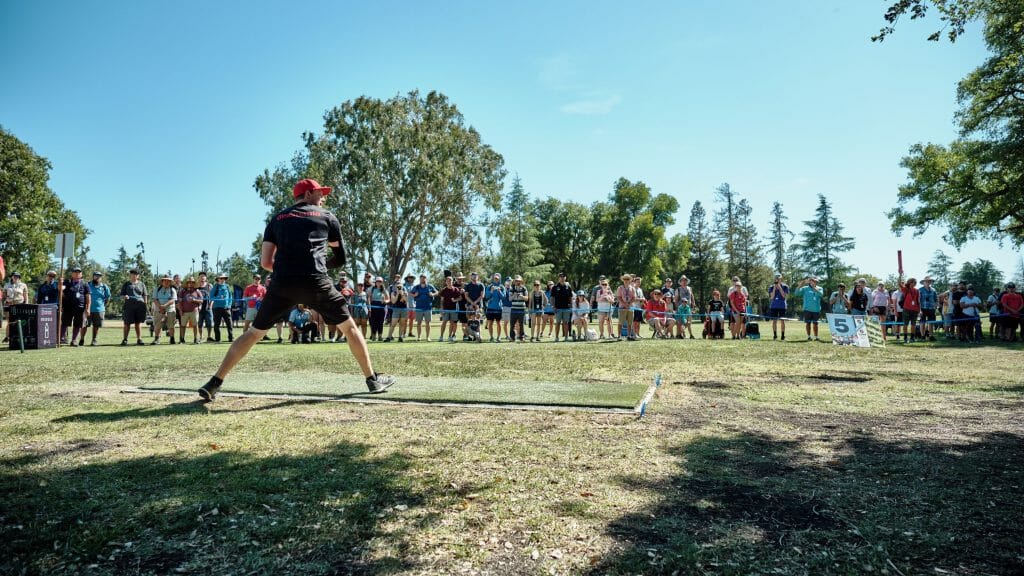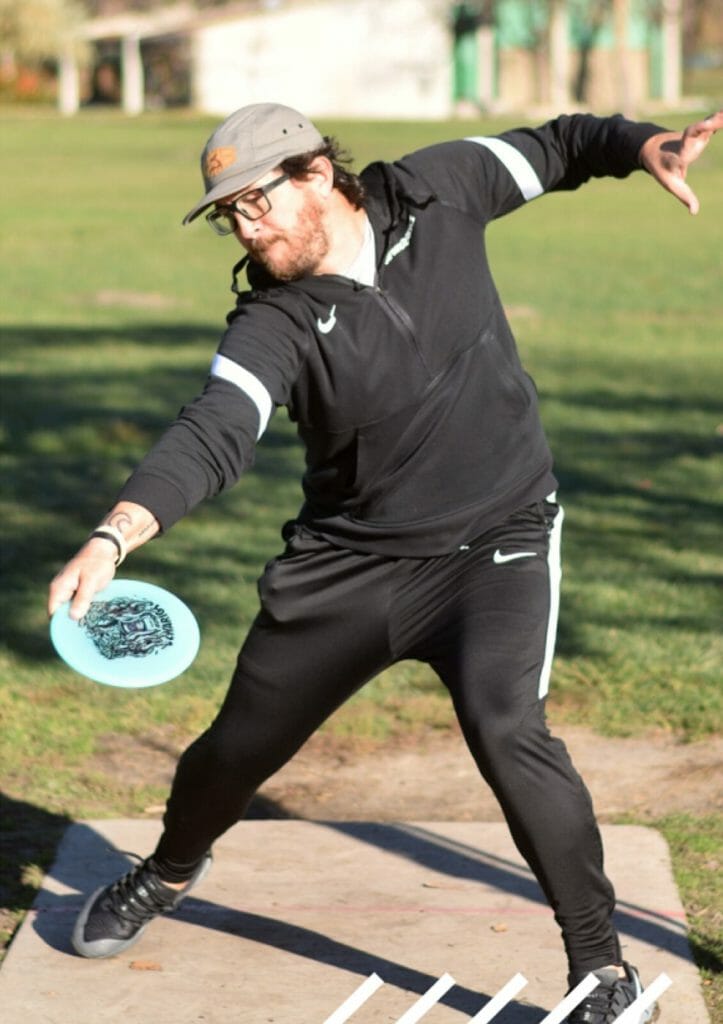Originally published at: https://discgolf.ultiworld.com/2023/01/10/tuesday-tips-easy-drills-to-fix-your-disc-golf-swing-before-spring-your-best-year-ever/
Many players are stuck – they love the game but are trapped on a scoring plateau. They can sometimes put together good rounds but only occasionally glimpse how good they could be. In rating terms, I think – barring serious mobility issues or injuries – nearly every player can earn a rating over 900. You can have more fun with just a bit more attention to form and course management. Now, at the start of the year, is the perfect time to work on your game to make sure this is your best year of disc golf yet.
This article will focus on helping improve your form. A lot of instructors and pros are offering online swing analysis and very precise descriptions about elbow angle, hip turn, and off-arm rotation to help players get better. This analysis is great, but I think lots of players find it hard to watch these videos and then take it to the course.
What I would like to offer is drills that can help you fix the overall shape and athleticism of your swing – holistic drills that improve your swing without requiring you to video yourself or be able to feel subtle differences in arm position or hip angle. Like the excellent “Twirlybird Drill” (or the revamped version) from Overthrow Disc Golf, the goal is to offer simple moves that can improve your overall form and help your swing. You can do many of them without going to a course or throwing a disc (which is especially important if you are, like me, watching the snow pile up outside.) While these tips and drills are meant to help players who aren’t reaching their potential, they are useful to players at all levels.
Get Your Grip
The grip does not get as much attention as it deserves. Many players I work with are really grinding on swing theory without ever revisiting the way they grip the disc. Having a grip that is comfortable, consistent, and gets the nose in the proper position is crucial to every shot. There are many ways a grip can go wrong, and sometimes your grip can subtly change over time without you noticing. If your grip is tilting up the nose of the disc, then no amount of work on your mechanics will get the results you want.
Get your grip right and periodically check it to make sure it is staying consistent.
https://www.youtube.com/watch?v=IJ_7uP6Amwo
The Body Connection Drill
One of the main problems for many players is a tendency to overuse the arm rather than their body to power their swing. The arms are important to the swing, of course, but they should be responding to your body turn. Your swing will be more consistent, more powerful, and more resistant to injury if you let your body drive your throw.
Many players simply do not turn their bodies. Their arms are “disconnected” from their body, and they do not allow their torso and legs to power the swing. While this can feel powerful – you feel like you are doing a lot – you can’t tap into the power of your levers and lose accuracy.
This drill helps you feel where your “natural extension” is – where your swing should stop. Your swing length should be a function of your body turn. To find this point, cross your arms across your chest, turn your hips and shoulders, and only once you have turned your body, extend your throwing arm – that is your backswing position.
https://www.youtube.com/watch?v=jKrl5vyZAj8
When your body turn stops, your swing stops. Don’t cheat by reaching your arm behind you to make your swing longer. Once you do, your arms are disconnected from your body and your timing will suffer. You will throw better, with more power and control, if you throw with connection, even if your swing feels “shorter” than you would like.
This drill mimics the proper sequence of a full shot, the arm extension should follow the body turn. It feels natural to start your swing with your hand and arm, but if your arm starts your swing, you are set up to round and lose power and accuracy. I discussed how to stop rounding in a video you can find here.
The Stride Drill
Perhaps the most important moment of the swing is when you are coming out of the x-step. Unless you “hop” into your throw like Steve Brinster or Eric Oakley, this crucial transition requires you to balance on one foot before you stride into your final step. Many players, however, move too quickly or lack the balance to get this sequence correct.
To do the drill, stand sideways with your feet even and about a hip width apart. Now take your lead foot and move it back to hover over your trail foot. Hold that balanced position, and then side-step into the finish position as you come out of the x-step. In every throw, there is that moment when you are balanced on your rear foot and your front foot is off the ground. Often, especially if we don’t work on our balance, we move through this spot as quickly as we can, or even stumble onto our plant foot. But this moment, with your torso coiled and your weight on your rear foot, is the highest point of potential energy in the swing. What happens next will determine how much power we will get into the shot.
A few keys to making your final step efficient. While you started the drill with your feet even, when you finish your stride, make sure that your feet are closed. That means that the front foot is closer to the target line than the rear foot. For a right-handed player, this means the rear toes are even with instep or heel of the front foot. You may go more closed than this (like Simon Lizotte and many power players do) or less, but closing your stance is crucial to generating power. If you land open – the front foot toes even with the rear heel (or even more open) you immediately lose the power from your hips and legs.
Also, when your lead foot lands, your hips should be opening. Don’t land with your weight centered between your feet. You want to feel that you are getting your weight into the front foot and your hips are turning towards your target. This drill, hovering and holding your balance, then striding into a closed position as your lower body unwinds, is the key to a solid, consistent swing. When you integrate it into your full swing, you may need to slow down to make sure you can stay balanced and get everything to happen in sequence.
https://www.youtube.com/watch?v=xjsM9qnikK4&t=6s
There is a lot more information on the importance of closing your stance and helpful videos in the article “Don’t Fake Your X-Step.”
Slow Acceleration Drill
Getting everything in sequence is hard if you go too fast. “Slow down” is one of the truisms of the game and perhaps the most common suggestion to fix a balky swing. But going slow is difficult, can feel unnatural, and if it is taken to an extreme, can drain a throw’s power and athleticism. Yes, going too quickly leads to lots of problems. However, going slow is not a cure-all. Going slow with bad mechanics just produces a bad swing that is slower.
Beyond this, going fast often only gives the illusion of power. Players who race in from a long run-up and quick x-step usually find themselves going too fast to throw in sequence, meaning their upper bodies rocket through before their feet are set. Their speed is too much for their technique, so they have to slow down as they approach the end of their throw to save their balance. This is backwards.
Rather than thinking of “swinging slow,” think of a gradual acceleration – most swings should start with a slow, almost lazy, first step and gradually pick up speed. The fastest part should be the quick acceleration in the final moments of the throw. Feel that your throw picks up speed as it goes, start slow to finish fast.
Hold the Pose
A great way to test if you are going too fast is to hold your finish position until the disc lands. That means no falling off the pad, no stumbles to catch your balance, no spinning out. Finish on your lead foot and then hold that balanced position until the disc lands. If you can’t keep your balance at the end of your throw you are going too fast, your weight is outrunning your brace foot.
Getting on Hyzer
One of the most important things for every player is being able to find a solid, repeatable hyzer angle. While you may move on to favor another flight shape, learning to throw a hyzer is the best building block for your swing. Many players who skip over this step and “just throw” build in all kinds of extra motions, rounding, and bad habits. It is hard to keep your disc on a consistent powerful hyzer angle if you round excessively or swing from the shoulders (which usually produces a weak anhyzer shot).
The simplest way to make sure you have a smooth hyzer is to check your swing at two points – make sure your disc is at hip level (at least) in the back swing, and your throwing hand finishes just over your front shoulder after you release the disc. For most players, this rear extension position will feel much lower than usual. It will feel weird but stick with it. Once you are getting the disc away from you and in a nice low position, then maintaining that angle, it is hard to take the disc into a rounded position behind you or initiate the swing with your upper body .
If you are habitually anhyzering the disc (like I was when I started), you may need to go into an exaggerated hyzer to get this feeling. Go lower than you feel comfortable in your backswing. You may need to get used to throwing deep, almost spike hyzer, shots to break your bad habits.
As an image to take with you to the practice field, think of Eric Oakley. Throw like Oakley, with an exaggerated low extension position. This isn’t how you will swing out on the course, but it ingrains important feelings, especially if you have been spinning out.
Eric Oakley. Photo: Infinite Discs.Once you are able to throw shots from this position, you can gradually raise your extension position higher to get a flatter shot if that is the flight you want. But learn to throw a hyzer focusing on these two points – a low extension and a finish just above the right shoulder. You will find your shots flying with more power and control.


